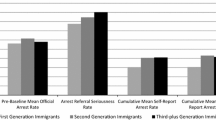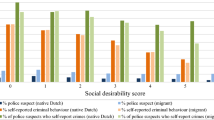Abstract
National Youth Survey Family Study (NYSFS) respondents were examined to identify the characteristics of individuals and their sociological environments, that would make them more likely to have consistency between self reported and officially recorded records of arrest. Somewhat surprisingly, it was found that those most likely to be at risk of arrest (males, high exposure to delinquent friends, higher level of substance use) are more likely to have consistency between officially recorded and self-reported arrests. Findings will be helpful in both producing more accurate information on arrests and in increasing sensitivity to the possibility of bias in arrest records that may be based on sociodemographic or behavioral characteristics of the individual.
Similar content being viewed by others
Notes
It should be noted that incarceration does not necessarily result in attrition for NYSFS respondents, as incarcerated individuals are also interviewed if possible.
Note that the Hollingshead and Redlich (1958) measure of SES uses a person’s academic attainment (number of years completed in school), while our measure of academic achievement uses estimated grades in school. Therefore, these two variables do not measure the same thing (i.e. there is no collinearity between these two measures). VIF and tolerance scores were run on all independent variables. VIF scores ranged from 1.092 to 1.487 and tolerance scores ranged from .916 to .673, again indicating no collinearity between any variables in any of the models.
Index offenses include the following: felony assault (sexual assault, aggravated assault, and gang fighting), robbery (using force or threat of force to take something), and felony theft (motor vehicle theft, burglary, and theft of something worth more than $50).
References
Babinski, L. M., Hartsough, C. S., & Lambert, N. M. (2001). A comparison of self-report of criminal involvement and official arrest records. Aggressive Behavior, 27, 44–54.
Blumstein, A., Cohen, J., Piquero, A. R., & Visher, C. A. (2010). Linking the crime and arrest processes to measure variations in the individual arrest risk per crime (Q). Journal of Quantitative Criminology, 26(4), 533–548.
Bosick, S. (2009). Operationalizing crime over the life course. Crime and Delinquency, 55(3), 472–496.
Brame, R., Fagan, J., Piquero, A. R., Schubert, C. A., & Steinberg, L. (2004). Criminal careers of serious delinquents in two cities. Youth Violence and Juvenile Justice, 2(3), 256–272.
Clark, J. P., & Tifft, L. L. (1966). Polygraph and interview validation of self-reported deviant behavior. American Sociological Review, 31, 826–834.
Elliott. (1995). Lies, damn lies and arrest statistics: The Sutherland award presentation. Boulder: Center for the Study and Prevention of Violence.
Elliott, D. S., & Ageton, S. S. (1980). Reconciling race and class differences in self-reported and official estimates of delinquency. American Sociological Review, 45(1), 95–110.
Elliott, D., Huizinga, D., & Menard, S. (1989). Multiple problem youth: Delinquency, substance use, and mental health problems. New York: Springer.
Emmert, A. D., Carlock, A. L., Lizotte, A. J., Krohn, M. D. (2015). Predicting adult under- and over-reporting of self-reported arrests from discrepancies in adolescent self-reports of arrests: A research note. Crime & Delinquency, 1–17. doi: 10.1177/0011128715575141.
Farrington, D. P., Loeber, R., Stouthamer-Loeber, M., Van Kammen, W. B., & Schmidt, L. (1996). Self-reported delinquency and a combined delinquency seriousness scale based on boys, mothers, and teachers: concurrent and predictive validity for African-Americans and Caucasians. Criminology, 34(4), 493–517.
Gold, M. (1966). Undetected delinquent behavior. Journal of Research in Crime and Delinquency, 3, 27–46.
Hindelang, M. J., Hirschi, T., & Weis, J. G. (1981). Measuring delinquency. Beverly Hills: Sage.
Hollingshead, A., & Redlich, F. (1958). Social class and mental illness: A community study. New York: Wiley.
Hser, Y.-I., Anglin, M. D., & Chou, C.-P. (1992). Reliability of retrospective self-report by narcotics addicts. Psychological Assessment, 4(2), 207–213.
Huizinga, D., & Elliott, D. S. (1986). Reassessing the reliability and validity of self-report delinquency measures. Journal of Quantitative Criminology, 2, 293–327.
Junger, M. (1989). Discrepancies between police and self-report data for Dutch racial minorities. British Journal of Criminology, 29(3), 273–284.
Kirk, D. S. (2006). Examining the divergence across self-report and official data sources on inferences about the adolescent life-course of crime. Journal of Quantitative Criminology, 22(2), 107–29.
Knight, G. P., Little, M., Losoya, S. H., & Mulvey, E. P. (2004). The self-report of offending among serious juvenile offenders: cross-gender, cross-ethnic/race measurement equivalence. Youth Violence and Juvenile Justice, 2(3), 273–295.
Krohn, M. D., Thornberry, T. P., Gibson, C. L., & Baldwin, J. M. (2010). The development and impact of self-report measures of crime and delinquency. Journal of Quantitative Criminology, 26(4), 509–525.
Krohn, M. D., Lizotte, A. J., Phillips, M. D., Thornberry, T. P., & Bell, K. A. (2013). Explaining systematic bias in self-reported measures: factors that affect the under- and over-reporting of self-reported arrests. Justice Quarterly, 30(3), 501–28.
Maxfield, M. G., Weiler, B. L., & Widom, C. S. (2000). Comparing self-reports and official records of arrests. Journal of Quantitative Criminology, 16(1), 87–110.
McGloin, J. M., Pratt, T. C., & Maahs, J. (2004). Rethinking the IQ-delinquency relationship: a longitudinal analysis of multiple theoretical models. Justice Quarterly, 21(3), 603–635.
Menard, S. (2010). Logistic regression: From introductory to advanced concepts and applications. Thousand Oaks: Sage Publications, Inc.
Menard, S., & Morse, B. J. (1984). A structuralist critique of the IQ-delinquency hypothesis: theory and evidence. American Journal of Sociology, 89(6), 1347–1378.
Menard, S., Mihalic, S., & Huizinga, D. (2001). Drugs and crime revisited. Justice Quarterly, 18, 269–299.
Menard, S., Morris, R. G., Gerber, J. G., & Covey, H. C. (2011). Distribution and correlates of self-reported crimes of trust. Deviant Behavior, 32, 872–917.
Morris, R. (1965). Attitudes toward delinquency by delinquents, non-delinquents, and their friends. British Journal of Criminology, 5, 249–265.
Piquero, A. R., Schubert, C. A., & Brame, R. (2014). Comparing official and self-report records of offending across gender and race/ethnicity in a longitudinal study of serious youthful offenders. Journal of Research in Crime and Delinquency, 51(4), 526–556.
Pollock, W., & Menard, S. (2014). “It was a bum RAP”: self-reports of being erroneously arrested in a national sample. Criminal Justice Review, 39(3), 325–338.
Pollock, W., Oliver, W., & Menard, S. (2014). Measuring the problem: a national examination of disproportionate police contact in the United States. Criminal Justice Review, 37(2), 153–173.
Pollock, W., Menard, S., Elliott, D., & Huizinga, D. (2015). It’s official: predictors of self-reported vs. officially recorded arrests. Journal of Criminal Justice, 43(1), 69–79.
Raudenbush, S., Byrk, A., Cheong, Y., Congdon, R., & du Toit. (2004). HLM6: hierarchical linear & nonlinear modeling. Lincolnwood: Scientific Software International, Inc.
Rosenbaum, J. E. (2009). Truth or consequences: the intertemporal consistency of adolescent self-report on the Youth Risk Behavior Survey. American Journal of Epidemiology, 169(11), 1388–1397.
Thompson, K. M., Leinfelt, F. H., & Smyth, J. M. (2006). Self-reported official trouble and official arrest: validating a piece of the core alcohol and drug survey. Journal of Substance Abuse, 11(1), 23–36.
Thornberry, T. P., & Farnworth, M. (1982). Social correlates of criminal involvement: further evidence on the relationship between social status and criminal behavior. American Sociology Review, 47(4), 505–518.
Thornberry, T. P., & Krohn, M. D. (2003). Comparison of self-report and official data for measuring crime. In J. V. Pepper & C. V. Petrie (Eds.), Measurement problems in criminal justice research: workshop summary (pp. 43–94). Washington: National Academies Press.
Ward, D. A., & Tittle, C. R. (1994). IQ and delinquency: a test of two competing explanations. Journal of Quantitative Criminology, 10(3), 189–212.
Weis, J. G. (1986). Issues in the measurement of criminal careers. In A. Blumstein, J. Cohen, J. A. Roth, & C. A. Visher (Eds.), Criminal careers and “Career Criminals,” (Vol. 2, pp. 1–51). Washington, DC: National Academy Press.
Author information
Authors and Affiliations
Corresponding author
Appendix
Rights and permissions
About this article
Cite this article
Pollock, W., Hill, M.C., Menard, S. et al. Predicting Consistency Between Officially Recorded and Self-Reported Records of Arrest. Am J Crim Just 41, 623–644 (2016). https://doi.org/10.1007/s12103-016-9343-9
Received:
Accepted:
Published:
Issue Date:
DOI: https://doi.org/10.1007/s12103-016-9343-9




